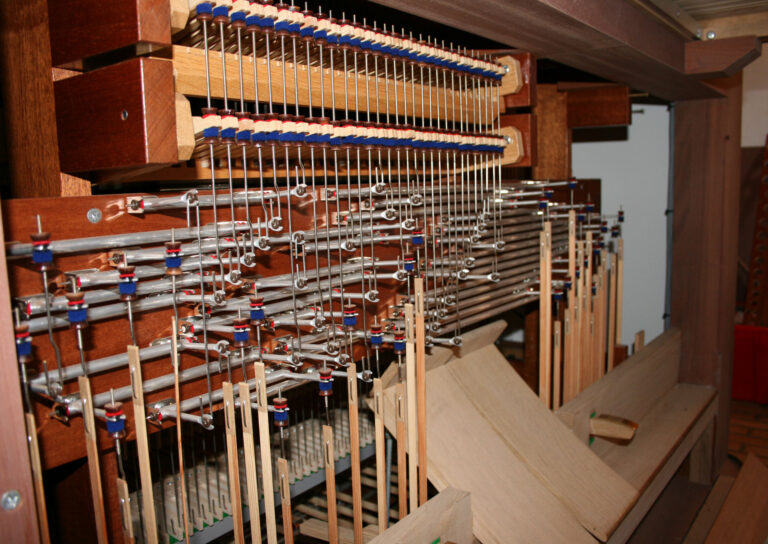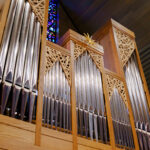Welcome Back! ( To Read Part 1 of this two part Blog Post Click Here )
When playing worship music of the ages on a small to medium-sized instrument, a tracker pipe organ can be a delight to hear and play! Some of the most famous works were composed on Tracker Pipe Organs. Bach, Franck, and Buxetehude played their music on Tracker pipe organs.
What affects the sound quality or intonation of a tracker instrument?
Like many delicately crafted instruments, there are many factors that can affect the sound quality or intonation of a tracker instrument. Starting with materials used in the construction of pipework, natural elements that impact acoustics to things like hand position, force and speed of playing, and movement of the tracker mechanical components. These are all important because, at the end of the day, the instrument is designed to be played by humans, no matter their playing styles or imperfections. One aspect of the mechanical characteristics relates to the organic interaction between the fingering and the keyboard components called the pluck.
It is important to note that some level of pluck is always present in a tracker organ, and this is deemed acceptable.
The intensity of the pluck is affected by the level of wind pressure, the surface area (length and width) of the pallet, and to a lesser extent, the tension of the pallet spring. This may manifest as differences in pluck when using different registrations/ divisions of the instrument. It is also worth noting that the pluck is not exactly overcome by finger pressure. Instead, as pluck point is approached, tension will build up in the trackers and linkages as they stretch, bend, twist, and tense. Pluck is overcome when this stored energy has enough force to move the pallet. The trackers then relax and the pallet is able to move freely. In this way, flexing trackers act as if they are small batteries which will assist in pallet movement- they store energy and release it at the appropriate time. Of course, this usually happens far too quickly to be easily perceived by the player or the listener.
One organist described his experience of playing a 66 rank tracker, ” when having a large combo out coupled down 3 manuals, it gets heavy to play. BUT FUN!.” Others have found tracker actions less forgiving and likely to expose flaws in one’s technique. Yet they acknowledge for the same reason, tracker organs make excellent practice instruments for mastering technique.
Tracker touch…. Uplifting tone
In a perfect world we would set all the trackers to be reasonably tense so that they can be played with minimal motion (organ technique preaches efficiency) and so that they return to their resting position quickly allowing repeated notes to be articulated clearly and rapidly.
Beauty is in the eye of the beholder
In the article “Can the Organist Control the Movement of the Pallet in a Mechanical Action”, the author delves into the accuracy of organists’ perception of pluck movement and explores ways in which pluck can be intentionally moved. There are various solutions to overcome a large pluck. These include lessening spring tension, adding slack to the trackers, using barker levers, employing smaller or tapered pallets, reducing the travel of a pallet, utilizing a balancer mechanism, creating secondary pallets, and optimizing regulation. Each of these improvements helps to make the tracker organ more accessible to organists accustomed to electric action. Frequently the answer to overcoming this very physical problem may actually lie in the mind and heart, as a conscious intentional exercise of accepting the inherent organic character of the instrument.

Audience and musician preferences: Tactile/Auditory
For musicians, often the act of playing their instrument is primarily tactile, and secondarily auditory. When studying differences in intonation on trackers when organists are playing quickly as opposed to slowly, it has been shown that most organists perceive the start of the note to be when their fingers move, not necessarily when the pluck point is reached or when the sound occurs. The sound actually takes time to emanate from the pipe. This is because it takes time for the air pressures to equalize around the newly opened pallet, for that pressure to reach the pipe, and for its vibrations in the pipe to stabilize into a pitch.
Under normal playing conditions, a pipe does not actually speak until the after key is fully depressed. Still, remember the organist/congregant thinks/perceives the pipe speaks when they begin to move their fingers. In this way, there can be a disconnect between the timing of all these actions and may be the root of the differences in perception to mostly discerning of players. The most important sensation is what they feel when they first start playing the key.
The best trackers have actions that are neither too heavy nor too light. The pluck gives a very nice feel, when the action is silky smooth and predictable throughout like the Wilhelm Tracker Pipe Organ below.

To the general audience of listeners/consumers, however, these variations are rarely noticeable.
In conclusion, understanding the pluck point of tracker pipe organs is essential for organists, organ builders and consumers. By exploring the fundamentals of tracker action, the effects of wind pressure, and managing pluck, tracker organs can be optimized for a more precise and controlled touch.
With practice, attention and care, nearly any tracker organ can become more accessible to organists and congregants accustomed to electric action. The pure natural sounds of a Tracker pipe organs can more perfectly accompany varying abilities in choral song and uplift worship.
Did you miss the Part 1? Click Here to Read Part 1
Sources/Credits:
http://organforum.com/forums/81986/S…ead.aspx#81986 http://www.sydneyoperahouse.com/uplo…GrandOrgan.pdf
http://www.nzorgan.com/
Expansion chambers under the pipe feet, Lawrence Phelps.




